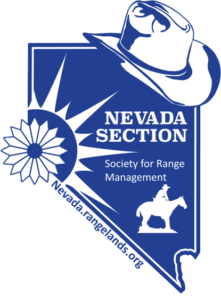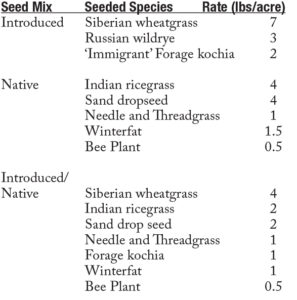A Case Study: Dry Lake Valley
 It is well documented how difficult of a task resource managers have when attempting to restore or rehabilitate disturbed or degraded habitats throughout the Great Basin.
It is well documented how difficult of a task resource managers have when attempting to restore or rehabilitate disturbed or degraded habitats throughout the Great Basin.
These challenges are multiplied many times over when attempting to restore or rehabilitate severely arid habitats. Rangeland revegetation has been around for more than a century and many experienced researchers have cautioned future researchers on the numerous frustrations that lay ahead when addressing the restoration or rehabilitation of range sites that are not only degraded, but also are severely limited by lack of effective amount and periodicity of annual precipitation. Sites that regularly receive less than 7” of annual precipitation often lack the necessary precipitation to achieve any level of revegetation success. Researchers have reported that favorable conditions to establish seeded plants in these arid environments may only occur 1 out of every 4 years, while others have reported the necessary conditions needed to recruit natural or artificially induced seedling recruitment vegetation may only occur 1 or 2 years out of every 15 years (Fig. 1). Nonetheless, many of these habitats are critical to wildlife as well as sustainable grazing practices.

In 2013, we were approached by the US Department of Interior, Bureau of Land Management (USDI-BLM) to investigate revegetation practices that could possibly reduce the exotic and introduced annual grass, cheatgrass, while at the same time improving grazing resources. Our first investigation to the site took place in June 2013 and we recorded that the habitat was a degraded winterfat/Indian ricegrass community, while the community was dominated by cheatgrass and Russian thistle with a sparse presence of winterfat, Indian ricegrass, galleta grass and sand drop seed. In 2015, a 5-acre exclosure was constructed to aid our research efforts on testing two soil-active, pre-emergent herbicides, Plateau (Imazapic) and Landmark XP (Sulfometuron-Methyl) to control invasive annual species such as cheatgrass. Pre-treatment data collection revealed a remnant perennial grass population of 0.14 perennial grasses/ft² (6,070/acre) dominated by Indian ricegrass and galleta grass with a shrub population of 0.03/ft² (1,335/acre) dominated by winterfat. The site appears to be very static in amount and periodicity of precipitation, nonetheless we set out with a goal of increasing the perennial grass density to 0.40/ft², to aid in the suppression of cheatgrass and significantly improve foraging resources. In the fall of 2016, we set up 12 randomized 60’ x 150’ plots which included herbicide applications with Plateau @ 6 oz/acre rate, Landmark @ 1.75 oz/acre rate and control plots (no herbicide application). Plots were sprayed in the fall of 2016, fallowed for 1 year and then seeded the following fall.
We also replicated these treatments a second year, 2017 application, fallowed for 1 year and seeded the following fall. The herbicide applications of both soil-active, pre-emergent herbicides significantly reduced invasive annual species in the treated plots (Fig. 2).

Cheatgrass densities were reduced from an average of 2.6/ft² in herbicide treated plots down to 0/ft² in May 2017 and 1.3 cheatgrass plants/ft² down to 0 cheatgrass/ft² in May 2018. Control plots remained above 2 cheatgrass plants/ft² in both recorded years 2017 and 2018. The site received 4.9” of annual precipitation from October 2017 through September 2018, year 1 of seedling growth year and 10.4” for the 2018/2019 precipitation year for seedling growth for the year 2 plots.
Following the 1 year fallow (activity period for these herbicides), we investigated the seeding of three seed mixes; 1) Introduced, 2) Native, and 3) Introduced/Native:

Herbicide treated and control plots were seeded in the fall of 2017 (Year 1) and 2018 (Year 2) using a Kincaid no-till experimental drill (Fig. 3). All plots were monitored using 10 randomized 3 ft² quadrats/plot that became fixed over-time to record monthly and annual mortality. In May 2018 we recorded seeded species seedling emergence and densities. Initial seedling emergence was not significantly different among pre-emergent herbicides with herbicide treated plots averaging 1.7/ft² in the Introduced plots, 0.90/ft² in Native plots and 1.2/ft² in the Introduced/Native seed mix plots. Seeding treatments in the Control plots averaged 0.70/ft² in the Introduced plots, 0.50/ft² in the Native plots and 0.80/ft² in the Introduced/Native seed mix plots. In September 2019 the survivability and establishment of seeded species in the Introduced, Native and Introduced/Native seed mix plots for year 1 was 0.80/ft², 0.40/ft² and 0.70/ft², respectfully. Plots seeded in 2018, year 2, resulted in initial average seedling densities of 2.5/ft² in the Introduced plots, 0.95/ft² in the Native plots and 2.4/ft² in the Introduced/Native seed mix plots. Control plots averaged 2.30/ft² in the Introduced plots, 1.4/ft² in the Native plots and 2.8/ft² in the Introduced/native seed mix plots as recorded in May 2019. In May 2020, seedling survivability and establishment in the year 2 plots decreased to 1.3/ft², 0.60/ft² and 1.3/ft² in the herbicide treated Introduced, native and Introduced/Native seed mix plots, respectfully, and 1.2/ft², 0.70/ft² and 0.90/ft² in the control plots. The significant increase in precipitation from year 1 to year 2 resulted in significant increases in seedling emergence and establishment of seeded species (Fig. 4), but did not result in a significant increase in cheatgrass (Fig. 5).



Cheatgrass appears to not be playing as much as a significant role at this site as it did back in 2017 when they were at 2.6/ft² as we only recorded 0.13 cheatgrass/ft² on average in all of our plots in May 2019, yet the Russian thistle density on the site has significantly increased from less than 0.9/ft² in 2017 to more than 9.4/ft² in 2019. Prior to treating these plots with soil-active, pre-emergent herbicides to control invasive annual species, and seeding the plots to separate seed mixes, the sites average perennial grass density was 0.14 perennial grasses/ft², whereas following the herbicide and seeding applications the site averages 0.90 perennial grasses/ft² (39,200/acre), a 600% increase, far surpassing the goal of 0.40 perennial grasses/ft². Siberian wheatgrass and Indian ricegrass were the most successful species used on this site.
More research needs to be conducted to see what effects the success and failure of shrub species like winterfat and ‘Immigrant’ forage kochia at this site as our efforts yielded very low and spotty success seeding these shrubs. Our investigation of using pre-emergent herbicides in these arid habitats resulted in effective weed control as well as reducing competition for seeded species at the seedling stage. The use of introduced species, such as Siberian wheatgrass, in these arid sites increases the level of success of establishing perennial grasses, reducing cheatgrass densities and providing increased forage value.
The use of Introduced/Native seed mixes can be used to hedge bet with seed mixes whereas during below average years the introduced species still perform at a level of success that is not experienced when using native species only and improve the overall density and quality of desirable forage and providing as an added tool to suppress invasive annuals such as cheatgrass.
By Charlie D. Clements and Dan N. Harmon
